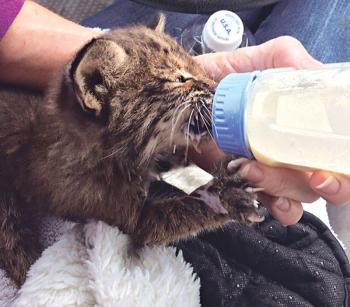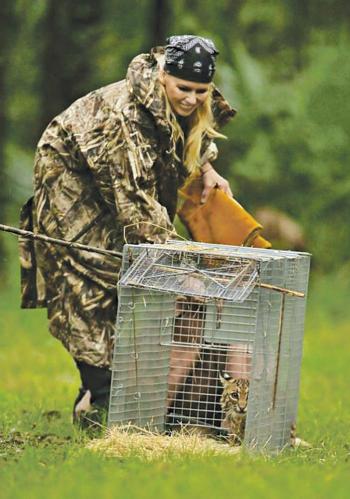Bobcats raised at Eunice refuge released into the wild
Almost two years after they passed through Eunice on their way to the Louisiana Bobcat Refuge, bobcats Hissy Fit aka Wild Child and Bitty Bit are back in the wild.
Pamela Kay, volunteer executive director for the refuge, said, “Wild Child was the third successful transfer we received from the Cypress Zoo (near Shreveport) and made a full recovery. There was only a slight hesitation, before his paws touched the grass on the other side of his transfer cage and he realized he was indeed free, as Mother Nature had intended. He gave me one last look, as if to say, ‘Tell everyone thanks for me’ and then he just blended into the canvas of the landscape.”
The two bobcats, who were on the cover of the Jan. 12, 2014, edition of The Eunice News, had been at the refuge since that January, and the felines were released in the last few weeks on Nature Conservancy property in the Acadiana area.
Hissy Fit, a male, was rescued by a Shreveport woman who discovered two dogs fighting over what she thought was a domestic kitten in her yard. As she rescued the feline from the two canines, the cat bit the woman, and it was then she realized it was no ordinary house cat. The woman then brought the animal to Dr. Gia Morgan, a veterinarian at Cypress Zoo.
Bitty Bit was also just a kitten when she was picked up off the side of the road by a man in Denham Springs. The man picked up the cat, also thinking it was a small, domestic cat, put it in his baseball cap and brought it home. A few days later, he also realized what he thought was a cat was actually a bobcat.
Both Hissy Fit and Bitty Bit were eventually transported to the refuge here in St. Landry Parish. The refuge has been open since 2010, and it is the only long-term rehabilitation facility for bobcats in Louisiana and as one of the only few in the country, also serves the southeastern U.S. The refuge also provides sanctuary for state zoo retired bobcats, Canada lynx and smaller exotic cat pet surrenders, abused exotics or illegally kept pet bobcats. Some of the rescue and rehabilitate bobcat kittens are found abandoned by hunters, bobcats hit in the road or nuisance trapped by animal control or the refuge. Felines from places including Morgan City, Mississippi and even Florida have called the facility home, and the refuge has also assisted Nova Scotia with setting up its bobcat rehabilitation program.
Kay declined to put a figure on the number of bobcats at the facility and assisted by the facility, citing safety concerns for the animals.
“It’s our promise that’s a long term commitment to provide specialized veterinary care, proper natural habitats and nutritional diets suitable for exotic cats, all very costly, but we keep our promises,” Kay said. “Unlike puppies and kittens with no-kill shelter options, exotic cats cannot be adopted out as pets and would be euthanized, were we not to take them. Most times, we are their last chance other than a death sentence through no fault of their own and one reason why we don’t recommend them as pets.”
“The neat thing to see is how these wild cats blossom under the peaceful conditions of no longer being on public display. Many of them become surrogates to the wild kittens that come into our rehab program.”
Kittens take a full year to rehabilitate before they can be released back into the wild, but some of the felines stay at the refuge permanently if they unable to return to wild, including Pearl, who is missing a paw after she was caught in a trap. Oftentimes these cats are used as surrogates for rescued kittens. According to Kay, bobcats can live upwards of 20 years.
While the refuge is self-funded and not open to the public , video and electronic means are used to document the work at the refuge, and these materials are shared with students and the public. Crews from Animal Planet and Nat Geo Wild in the UK have also visited the refuge.
“They have no bobcats in their country,” Kay said. “Realizing that there is international attention focused right here in Acadiana on our bobcats, highlights their significance and value to the world. We believe it’s important to help others learn more about our state cat and why it’s important to our environment. We even teach about humane predator control options for those with poultry to learn better ways to protect their poultry pens from wildlife.”
In the future, the refuge will implement a GPS and scent pad tracking study to determine an accurate account of how many bobcats actually live in the state.
“Currently, only two states have done similar studies, so, you can only imagine how excited we are to help Louisiana, as Sportman’s Paradise, be ahead of the rest of the nation when it comes to understanding, preserving and protecting our only Louisiana indigenous cat- the Bobcat,” Kay said. “ In my lifetime, I never expected lions, cheetahs and tigers to end up on the endangered species list, but they have…too little too late, which is why the Louisiana Bobcat Refuge also works in the area of conservation, besides the hands on work we do with the bobcat rehab, sanctuary and school visits.”
Kay would also like to be able to outfit the released bobcats with tags and GPS monitors, but funding will be needed for the project. The refuge will hold an “I Shot a Bobcat” campaign for hunters to enter bobcat photos taken by their game cameras. Only live bobcats are eligible for documentation purposes, and photos can be emailed to the refuge.
To contact Claudette Olivier, email claudette.olivier@eunicetoday.com.
- Log in to post comments


